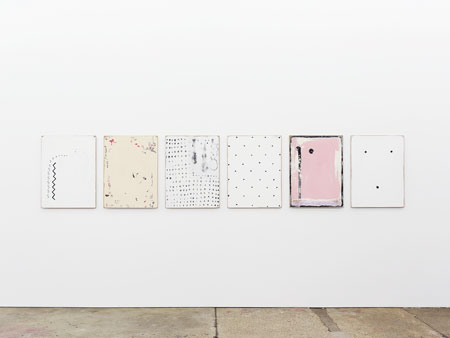Zin Taylor

Where other animals are set apart from us by their inability to speak, the parrot is an anomaly, a ‘stowaway who has managed to sneak across the border into the realm of speech’, as writer Steven Connor puts it. In Zin Taylor’s second exhibition at Supportico Lopez, ‘Parrot Soup’, the talkative bird made several furtive appearances: in a colour spectrum resembling a macaw’s wing, a soft squawk interjecting into a spoken narrative, and in the exhibition’s press release, which began: ‘Wild Parrots have infested the park by where I live. A company of 20 moved in, and never left. Parrots are incredibly loud and bossy – like a gang of random thoughts loitering in the public space ...’
The show comprised three new works or ‘units’, as the artist calls them, each carrying equal weight: a hanging mobile with the descriptive title A string of eyeballs, a spectrum of color, a structure of form in black and white (all works 2013); a set of six painted panels (Thoughts collected on the surface of a panel [snake speaking a pattern]); and an audio track entitled Parrot Soup. Written and spoken by the artist, who is a gifted writer, the audio narrative discusses various topics relating to underground music culture – a subject that recurs throughout his practice. The story covers his introduction to feminism through listening to the music of Bikini Kill, for example, and the phenomenon of the independent record shop. Reminiscent of the radio programme This American Life, Taylor’s narrative is a confessional monologue: intimate, unflinchingly autobiographical and always highly engaging.
The visual and sculptural components of the exhibition sometimes bore direct reference to this narrative. One painted panel depicts the faded remnants of a ‘USA is a Monster’ T-shirt, which the artist’s narrative subjected to a socio-cultural analysis that was at once humorous and incisive. At other times, the connections were more ambiguous. The mobile was both literally and metaphorically up in the air. It turned unevenly, its meanings uncertain. Its shape resembled a walking stick or an upside-down repeating ‘L’. On one side hung a string of crudely painted spheres resembling eyeballs – perhaps it was a parrot’s perch, or ‘an undulating mass turning in synch with the band that is playing’ (Taylor’s description of the mosh pit).
The parrot’s voice is a type of recording medium, but one that is often faulty and irregular. It is a broken phonographic device, as in James Joyce’s line from Ulysses (1922): ‘have a gramophone in every grave or keep it in the house […] Kraahraark! Hellohellohello amawfullyglad kraark awfullygladaseegain.’ For Taylor, the subversions and reiterations of underground music offer a parallel. These are forms that travel through imperfect reverberations, often oscillating between raw and immediate expression and the formulaic composition of mainstream, commercial music. Rather than the politics of resistance, however, what comes to the fore in Taylor’s narrative is an investigation of the very structure and syntax of artistic form. His story concludes with the suggestion that the four members of the Grindcore band The Locust are, in fact, a type of fluvial entropic ooze, a malleable substance that changes with each performance. This weird and comical proposition reflects in a roundabout way on the materiality of sculpture. His description of a distillery as a ‘machine that gives form to thought’ – pushing hazy substances through copper pipes until they are expelled into the physical world as material forms – could well be a metaphor for the process of making art, of moving from mind to matter.
For many artists working since the 1970s, language has offered a way to circumvent or resist the art object. ‘Parrot Soup’ made the important point that the voice and the object are very much interdependent. Overturning the claim to immateriality that such language-based practices hold, Taylor’s interest in the voice is accessed through a preoccupation with sculptural and visual forms. For, as the parrot may sneak into the realms of language, so language solidifies into ‘objects and subjects, things and spaces, thoughts and forms’. hellohellohello amawf krpthsth.
















